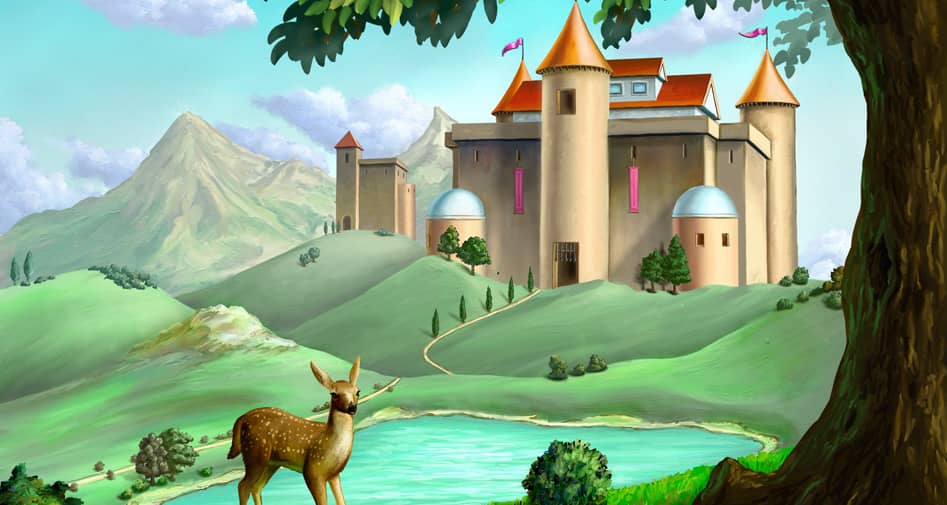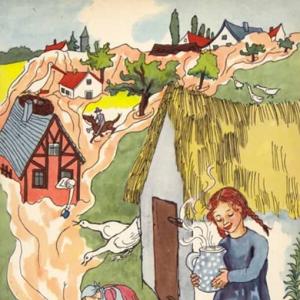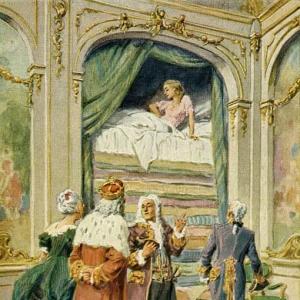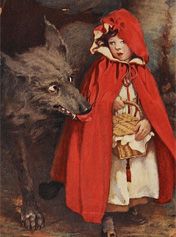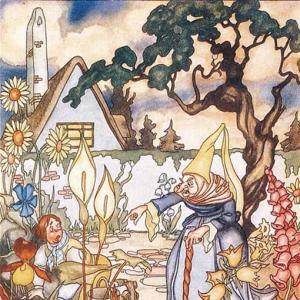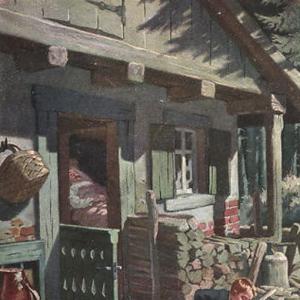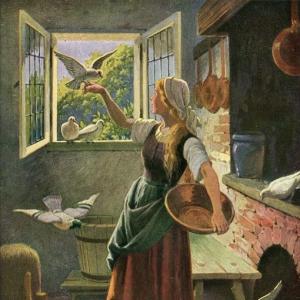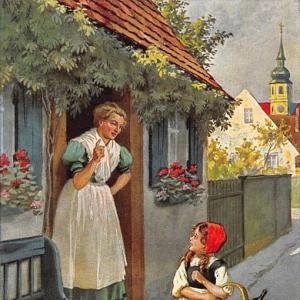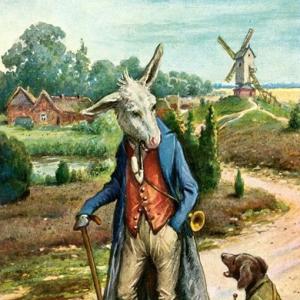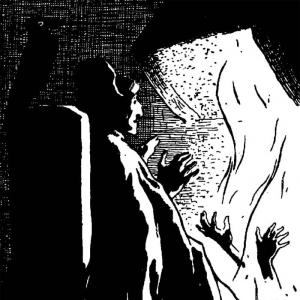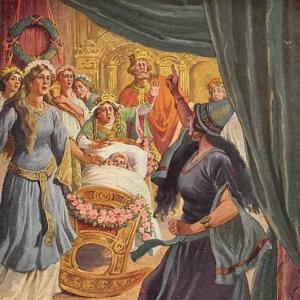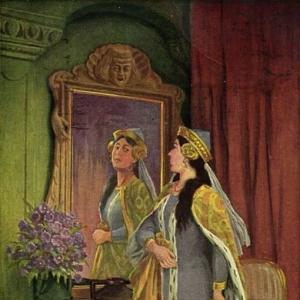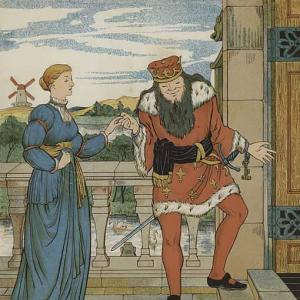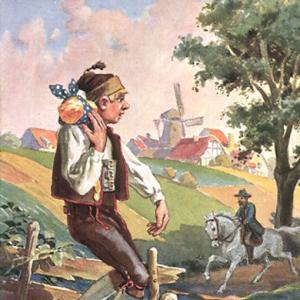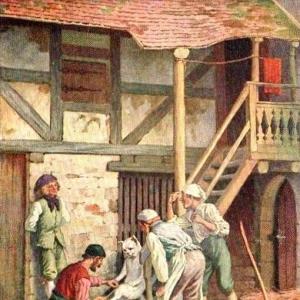Reading time for children: 14 min
There was once upon a time a rich King who had three daughters, who daily went to walk in the palace garden, and the King was a great lover of all kinds of fine trees, but there was one for which he had such an affection, that if anyone gathered an apple from it he wished him a hundred fathoms underground. And when harvest time came, the apples on this tree were all as red as blood. The three daughters went every day beneath the tree, and looked to see if the wind had not blown down an apple, but they never by any chance found one, and the tree was so loaded with them that it was almost breaking, and the branches hung down to the ground. Then the King’s youngest child had a great desire for an apple, and said to her sisters, „Our father loves us far too much to wish us underground, it is my belief that he would only do that to people who were strangers.“ And while she was speaking, the child plucked off quite a large apple, and ran to her sisters, saying, „Just taste, my dear little sisters, for never in my life have I tasted anything so delightful.“ Then the two other sisters also ate some of the apple, whereupon all three sank deep down into the earth, where they could hear no cock crow. When mid-day came, the King wished to call them to come to dinner, but they were nowhere to be found. He sought them everywhere in the palace and garden, but could not find them. Then he was much troubled, and made known to the whole land that whosoever brought his daughters back again should have one of them to wife. Hereupon so many young men went about the country in search, that there was no counting them, for every one loved the three children because they were so kind to all, and so fair of face. Three young huntsmen also went out, and when they had travelled about for eight days, they arrived at a great castle, in which were beautiful apartments, and in one room a table was laid on which were delicate dishes which were still so warm that they were smoking, but in the whole of the castle no human being was either to be seen or heard. They waited there for half a day, and the food still remained warm and smoking, and at length they were so hungry that they sat down and ate, and agreed with each other that they would stay and live in that castle, and that one of them, who should be chosen by casting lots, should remain in the house, and the two others seek the King’s daughters. They cast lots, and the lot fell on the eldest. So next day the two younger went out to seek, and the eldest had to stay home. At mid-day came a small, small mannikin and begged for a piece of bread, then the huntsman took the bread which he had found there, and cut a round off the loaf and was about to give it to him, but whilst he was giving it to the mannikin, the latter let it fall, and asked the huntsman to be so good as to give him that piece again. The huntsman was about to do so and stooped, on which the mannikin took a stick, seized him by the hair, and gave him a good beating. Next day, the second stayed at home, and he fared no better. When the two others returned in the evening, the eldest said, „Well, how have you got on?“
„Oh, very badly,“ said he, and then they lamented their misfortune together, but they said nothing about it to the youngest, for they did not like him at all, and always called him Stupid Hans, because he did not exactly belong to the forest. On the third day, the youngest stayed at home, and again the little mannikin came and begged for a piece of bread. When the youth gave it to him, the elf let it fall as before, and asked him to be so good as to give him that piece again. Then said Hans to the little mannikin, „What! canst thou not pick up that piece thyself? If thou wilt not take as much trouble as that for thy daily bread, thou dost not deserve to have it.“ Then the mannikin grew very angry and said he was to do it, but the huntsman would not, and took my dear mannikin, and gave him a thorough beating. Then the mannikin screamed terribly, and cried, „Stop, stop, and let me go, and I will tell thee where the King’s daughters are.“ When Hans heard that, he left off beating him and the mannikin told him that he was an earth mannikin, and that there were more than a thousand like him, and that if he would go with him he would show him where the King’s daughters were. Then he showed him a deep well, but there was no water in it. And the elf said that he knew well that the companions Hans had with him did not intend to deal honourably with him, therefore if he wished to deliver the King’s children, he must do it alone. The two other brothers would also be very glad to recover the King’s daughters, but they did not want to have any trouble or danger. Hans was therefore to take a large basket, and he must seat himself in it with his hanger and a bell, and be let down. Below were three rooms, and in each of them was a princess, with a many-headed dragon, whose heads she was to comb and trim, but he must cut them off. And having said all this, the elf vanished. When it was evening the two brothers came and asked how he had got on, and he said, „pretty well so far,“ and that he had seen no one except at mid-day when a little mannikin had come and begged for a piece of bread, that he had given some to him, but that the mannikin had let it fall and had asked him to pick it up again; but as he did not choose to do that, the elf had begun to lose his temper, and that he had done what he ought not, and had given the elf a beating, on which he had told him where the King’s daughters were. Then the two were so angry at this that they grew green and yellow. Next morning they went to the well together, and drew lots who should first seat himself in the basket, and again the lot fell on the eldest, and he was to seat himself in it, and take the bell with him. Then he said, „If I ring, you must draw me up again immediately.“ When he had gone down for a short distance, he rang, and they at once drew him up again. Then the second seated himself in the basket, but he did just the same as the first, and then it was the turn of the youngest, but he let himself be lowered quite to the bottom. When he had got out of the basket, he took his hanger, and went and stood outside the first door and listened, and heard the dragon snoring quite loudly. He opened the door slowly, and one of the princesses was sitting there, and had nine dragon’s heads lying upon her lap, and was combing them. Then he took his hanger and hewed at them, and the nine fell off. The princess sprang up, threw her arms round his neck, embraced and kissed him repeatedly, and took her stomacher, which was made of pure gold, and hung it round his neck. Then he went to the second princess, who had a dragon with five heads to comb, and delivered her also, and to the youngest, who had a dragon with four heads, he went likewise. And they all rejoiced, and embraced him and kissed him without stopping. Then he rang very loud, so that those above heard him, and he placed the princesses one after the other in the basket, and had them all drawn up, but when it came to his own turn he remembered the words of the elf, who had told him that his comrades did not mean well by him. So he took a great stone which was lying there, and placed it in the basket, and when it was about half way up, his false brothers above cut the rope, so that the basket with the stone fell to the ground, and they thought that he was dead, and ran away with the three princesses, making them promise to tell their father that it was they who had delivered them, and then they went to the King, and each demanded a princess in marriage.
In the meantime the youngest huntsman was wandering about the three chambers in great trouble, fully expecting to have to end his days there, when he saw, hanging on the wall, a flute. Then said he, „Why dost thou hang there, no one can be merry here?“ He looked at the dragons, heads likewise and said, „You too cannot help me now.“ He walked backwards and forwards for such a long time that he made the surface of the ground quite smooth. But at last other thoughts came to his mind, and he took the flute from the wall, and played a few notes on it, and suddenly a number of elves appeared, and with every note that he sounded one more came. Then he played until the room was entirely filled. They all asked what he desired, so he said he wished to get above ground back to daylight, on which they seized him by every hair that grew on his head, and thus they flew with him onto the earth again. When he was above ground, he at once went to the King’s palace, just as the wedding of one princess was about to be celebrated, and he went to the room where the King and his three daughters were. When the princesses saw him they fainted. Hereupon the King was angry, and ordered him to be put in prison at once, because he thought he must have done some injury to the children. When the princesses came to themselves, however, they entreated the King to set him free again. The King asked why, and they said that they were not allowed to tell that, but their father said that they were to tell it to the stove. And he went out, listened at the door, and heard everything. Then he caused the two brothers to be hanged on the gallows, and to the third he gave his youngest daughter, and on that occasion I wore a pair of glass shoes, and I struck them against a stone, and they said, „Klink,“ and were broken.
 Learn languages. Double-tap on a word.Learn languages in context with Childstories.org and Deepl.com.
Learn languages. Double-tap on a word.Learn languages in context with Childstories.org and Deepl.com.Backgrounds
Interpretations
Adaptions
Summary
Linguistics
„The Gnome“ is a fairy tale collected by the Brothers Grimm, Jacob and Wilhelm, who were German academics, linguists, cultural researchers, and authors. They are best known for their collection of German and European folk tales, first published in 1812 as „Kinder- und Hausmärchen“ (Children’s and Household Tales), which has been translated into over 100 languages.
The Brothers Grimm were born in the late 18th century in Hanau, Germany, and devoted their careers to collecting, preserving, and studying folk tales from various regions. Their work aimed to capture the cultural heritage and traditions of their time, which were being threatened by industrialization and urbanization. The Grimm brothers were also influential in the development of the German language and are considered pioneers in the field of folklore studies.
„The Gnome,“ like many other Grimm fairy tales, features motifs such as magic, quests, enchantments, and the classic theme of good triumphing over evil. These stories often convey moral lessons, reflecting the values of the society from which they originated.
The Brothers Grimm fairy tales have had a lasting impact on literature, inspiring countless adaptations, reinterpretations, and retellings, in various forms of media, including books, films, and theater productions. Their stories have become an integral part of the global cultural heritage and continue to be enjoyed by generations of children and adults alike.
„The Gnome“ by Brothers Grimm can be interpreted in various ways, touching on themes of greed, betrayal, courage, and justice. Here are some possible interpretations:
Greed and betrayal: The two elder huntsmen display greed and selfishness, as they try to claim the reward for saving the princesses without actually doing the work or facing the dangers. Their betrayal of Hans shows the negative consequences of greed, which ultimately leads to their downfall.
Courage and persistence: Hans, the youngest huntsman, is portrayed as a courageous and persistent character. Despite being underestimated by his brothers, he faces the challenges head-on and saves the princesses. His determination and resilience are rewarded when he marries the youngest princess and the truth about his brothers‘ deceit is revealed.
The importance of inner virtues: Hans demonstrates qualities like honesty, kindness, and intelligence, which help him overcome the challenges in the story. This can be seen as a lesson that inner virtues are more important than external appearances, as Hans‘ good character eventually leads to his success.
The power of music and magic: The flute Hans finds in the underground chambers represents the transformative power of music and magic. The flute’s ability to summon the elves that help Hans return to the surface is a reminder of the potential for magical and unexpected solutions to seemingly insurmountable problems.
Justice and truth: The story highlights the importance of justice and the eventual triumph of truth. The King, after learning the truth about Hans‘ actions and his brothers‘ deceit, ensures that justice is served by punishing the two elder brothers and rewarding Hans with his youngest daughter’s hand in marriage. This can be interpreted as a message that, in the end, the truth will prevail, and those who do good will be rewarded.
„The Gnome“ is a classic fairy tale that has inspired several adaptations in various forms of media. Some notable adaptations include.
Operas: The story has been adapted into several operas, including „Der Zwerg“ by Alexander von Zemlinsky and „Il Gobbo“ by Ermanno Wolf-Ferrari.
Films: There have been several film adaptations of „The Gnome,“ including the 1980 film „The Elf Who Didn’t Believe,“ which is a loose adaptation of the story, and the 2011 film „Gnomeo & Juliet,“ which features a gnome as the main character.
Literature: The story has been adapted into children’s books, such as „The Cobbler and the Gnome“ by Jan Wahl, and also appears in several collections of Grimm’s Fairy Tales.
Theater: „The Gnome“ has also been adapted into plays, such as the 1995 play „The Gnome“ by Jonathan Fitts.
Video games: The story has been adapted into video games, such as the 2011 game „The Tiny Bang Story,“ which features a gnome character who helps the player solve puzzles.
These adaptations often vary in their interpretation of the story and its themes, but they all draw inspiration from the original fairy tale collected by the Brothers Grimm.
In the fairy tale „The Gnome“ by the Brothers Grimm, a King has three daughters and a special tree with apples he cherishes. When the daughters eat the apples, they are transported underground. The King announces that whoever finds his daughters can marry one of them. Three huntsmen, including the youngest, Hans, embark on this quest.
The huntsmen find a mysterious castle with no inhabitants, and they decide to stay. While two of the huntsmen go out searching for the princesses, the youngest remains in the castle. A mannikin visits each of the huntsmen on separate days, asking for bread. The first two give him bread, but when the mannikin drops it, they pick it up for him and suffer a beating. When Hans encounters the mannikin, he refuses to pick up the dropped bread, leading to a scuffle, during which the mannikin reveals the princesses‘ location and warns Hans against his brothers.
Hans finds the princesses underground, guarded by dragons. After slaying the dragons, Hans sends the princesses up in a basket, but his brothers betray him and leave him behind. The brothers take credit for saving the princesses and demand their hands in marriage.
Meanwhile, Hans finds a flute in the underground chambers and plays it, summoning a group of elves who help him return to the surface. He arrives at the palace during a wedding celebration for one of the princesses, but is imprisoned when the King assumes he has harmed his daughters. The princesses revive and plead for Hans‘ release, and the King orders them to reveal their story to a stove, which he eavesdrops on. The King then has the two deceitful brothers executed and marries Hans to his youngest daughter.
The Brothers Grimm’s „The Gnome“ is a fairy tale rich with linguistic and thematic elements typical of traditional folklore.
Narrative Structure: The story follows a classic fairy tale structure with a clear sequence: exposition, rising action, climax, falling action, and resolution. It begins with a typical „once upon a time“ introduction, establishing the setting and main characters: the King and his three daughters. The narrative employs a journey motif, common in fairy tales, where characters must travel, face challenges, and ultimately achieve a resolution.
Characterization: Characters are archetypical and often lack detailed individualization. The King, his daughters, and the huntsmen represent specific roles rather than complex individuals. The use of descriptors like “Stupid Hans” highlights the use of stock character types in fairy tales, providing immediate reader understanding of roles. The „little mannikin“ or gnome functions as a magical helper, a recurring trope where a supernatural being assists the protagonist.
Common Themes: Themes of temptation and consequence appear when the daughters’ desire for the apple has adverse outcomes. Deception and betrayal are evident in the huntsmen brothers‘ betrayal of the youngest. Justice and retribution are central themes, as seen in the fate of the dishonest brothers versus the reward for Hans. Themes of true nobility are explored through the actions of the least expected hero, Hans, challenging appearances and societal roles.
Magical Realism: Magical elements such as elves, dragons, and enchanted objects are woven seamlessly into the narrative. The story does not question or explain the magical aspects, maintaining a world where the extraordinary is accepted as part of reality.
Symbolism: The apples symbolize forbidden knowledge or desire, akin to the biblical story of Adam and Eve. The act of being buried underground symbolizes punishment or a trial that must be overcome. The flute serves as an emblem of hope and deliverance, highlighting music’s power to summon assistance and change fate. The stomacher of gold given by the princess symbolizes reward and recognition for bravery and virtue.
Language and Style: The use of direct dialogue promotes simplicity and accessibility, characteristic of oral storytelling traditions. Repetitive phrases and sequences, such as the encounters with the mannikin, aid in memorability and reinforce key narrative points. The tale employs vivid descriptive language, creating clear images like the “red as blood” apples and the “many-headed dragon. ”
Moral: The tale imparts moral lessons about the virtue of honesty, bravery, and the dangers of deceit. It asserts that true worth often lies hidden beneath humble or underestimated exteriors.
Overall, „The Gnome“ reflects the linguistic simplicity and moral profundity that characterize fairy tales. Its use of archetypical characters, thematic depth, and fantastical elements illustrates the Brothers Grimm’s ability to convey universal truths through accessible and engaging storytelling.
Information for scientific analysis
Fairy tale statistics | Value |
|---|---|
| Number | KHM 91 |
| Aarne-Thompson-Uther-Index | ATU Typ 301A |
| Translations | DE, EN, DA, ES, PT, IT, JA, NL, PL, RU, TR, VI, ZH |
| Readability Index by Björnsson | 40.5 |
| Flesch-Reading-Ease Index | 72.1 |
| Flesch–Kincaid Grade-Level | 10.8 |
| Gunning Fog Index | 13.6 |
| Coleman–Liau Index | 7.5 |
| SMOG Index | 9.2 |
| Automated Readability Index | 12 |
| Character Count | 9.496 |
| Letter Count | 7.360 |
| Sentence Count | 61 |
| Word Count | 1.858 |
| Average Words per Sentence | 30,46 |
| Words with more than 6 letters | 186 |
| Percentage of long words | 10% |
| Number of Syllables | 2.279 |
| Average Syllables per Word | 1,23 |
| Words with three Syllables | 65 |
| Percentage Words with three Syllables | 3.5% |
